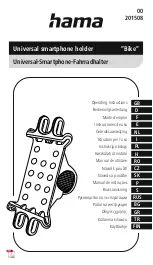
8510 Capabilities
STE User’s Manual
9-4
Rel. 2.6
9-2.1.9 Secure Call Feature Lockout
When the STE is actively involved in a secure call, activation of features will not be allowed. Pressing
any feature button while in a secure call will result in a “bad beep” and the feature will not be activated.
9-3. NON-SECURE
CALLING
The STE may be used for non-secure calling if the terminal strapping (initial secure mode) is set to
traditional or auto-secure. To fully utilize switch features, we recommend that traditional strapping be
selected when the STE is set to the STE-8510 switch type. Setting STE strapping to auto-secure may
cause unpredictable behavior of features, because the terminal automatically changes between non-
secure and secure modes. Setting the STE strapping to secure only is not recommended, because no
switch features are accessible with that strapping.
Placing non-secure calls from the STE is very similar to operation with a Lucent® 8510 terminal. Calls
can be placed from either the handset or the speakerphone. Going off hook with either the handset or
speakerphone will provide a call appearance to you. One of the call appearance LEDs will illuminate and
the call can be controlled using the associated call appearance button. Pressing the MUTE button will
mute an active call. Pressing the mute button again will unmute the call. Pressing the HOLD button will
put the active call on hold and cause the associated call appearance indicator to flash. Because adjunct
control is not allowed, if a second call appearance button is pressed with a call on hold, you must also
press the SPKR button or lift the handset to go off-hook on that call appearance. This differs from the
Lucent® 8510 terminal, which will go off-hook immediately when the call appearance button is pressed.
(See Paragraph
NOTE
The TPA must enable the non-secure speakerphone before it can be used.
9-4. SWITCH FEATURE SUPPORT
This section provides an overview of switch features supported by the STE. Paragraph
describes
supported features offered by both the 5ESS and DEFINITY switches. Paragraph
describes
supported features only available on the 5ESS switch. Paragraph
describes supported features
only available on the DEFINITY switch.
9-4.1
Common Switch Features
9-4.1.1 Alerting (Ring Patterns)
You can select from one standard and five alternate ring patterns to distinguish your STEs ring pattern
from that of adjacent STEs. Each ring pattern will provide a distinct sound in response to the five alerting
patterns sent from the switch.
The five alerting patterns that can be sent from the switch include a normal ring, a forwarding ring, a
priority ring, an intergroup ring and an intercom ring. The forwarding ring occurs when an incoming call
has been forwarded from another terminal.
The priority ring occurs when an incoming call is being made
from a terminal using the priority feature.
NOTE
“PRIORITY” is also displayed on the front panel for incoming priority calls.
The intergroup ring occurs when a call outside of the local switch network is received at the STE. The
intercom ring occurs when an incoming call is received from a member of your intercom group.
9-4.1.2 DEFINITY
Auto
Callback/5ESS Repeat Call
This feature has different names depending on which switch is used but the function works the same on
each. This feature continues to attempt to reach a dialed number for up to 30 minutes and provides the
Summary of Contents for CEU
Page 2: ...Copyright 2006 L 3 Communications Corporation ...
Page 26: ...List of Tables STE User s Manual xiv Rel 2 6 This page intentionally left blank ...
Page 32: ...Introduction STE User s Manual 1 6 Rel 2 6 This page intentionally left blank ...
Page 132: ......
Page 181: ...STE User s Manual Crypto Card Management Rel 2 6 6 25 ...
Page 182: ......
Page 210: ...Calls STE User s Manual 7 28 Rel 2 6 This page intentionally left blank ...
Page 234: ...Remote Control Operations STE User s Manual 8 24 Rel 2 6 This page intentionally left blank ...
Page 258: ...8510 Capabilities STE User s Manual 9 24 Rel 2 6 This page intentionally left blank ...
Page 284: ...User Maintenance STE User s Manual 11 6 Rel 2 6 This page intentionally left blank ...
Page 288: ...Notes STE User s Manual 12 4 Rel 2 6 12 4 CE DECLARATION OF CONFORMITY ...
Page 306: ...Index STE User s Manual Index 18 Rel 2 6 This page intentionally left blank ...
Page 308: ...Rel 2 6 FP 2 FO 2 User Tree ...
Page 311: ......
















































